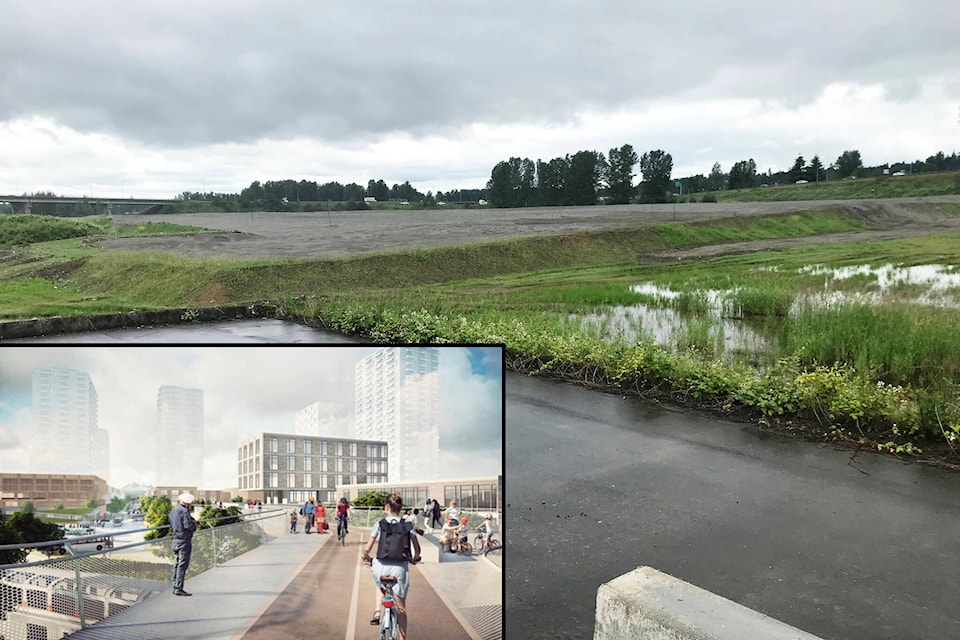Mission’s waterfront master plan has been adopted into the OCP, but not everyone is happy about it – including the largest landowners.
A public hearing was held on June 20, followed by a 6-1 vote in favour of amending the OCP to reference the vision on future land use on 296 acres of riverside property.
The document itself, staff and most councillors stressed, is a “living document,” and therefore flexible to change. That fact did not stop heavy criticism of its details.
Following the vote, Mayor Paul Horn summarized the hearing with one word: “doubt.”
“I think the only way we can get people on board is getting the bus to start driving,” he said. “What happens if somebody comes along and says, I can do something better? I don’t know about you, but I’m listening.
‘Let’s talk about how it can work with other things.’”
Kenny and Bobby Braich, owners of the most developable 87 acres, spoke at length and voiced serious concerns about feasibility, optics and misinformation in the public perception.
Both wanted the adoption to be deferred until a later date, after more public engagement and consulting.
RELATED: Waterfront-gate: Mission mayor claims ‘smear campaign’ on development controversy
The master plan is meant to act as “an enabler,” said Gerald Schlesiger, the project manager. He said the amendment does not stop discussion, but adds credibility and traction to council’s vision.
“The plan is at its beginning, not at its end,” Schlesiger said.
The Braich family’s industrial-zoned land has been up for sale since early 2022. Kenny said the family has run a global marketing campaign to attract some of the biggest developers in the world, but the interest in the city’s current vision is not there.
He described the plan as “fatally flawed” for not utilizing the foreshore as a sea shipping port, and instead using it for public amenities.
“We have beaches instead of container ports,” Kenny said, adding one kilometre of foreshore with rail access this far up the Fraser River is an extremely rare asset.
The only interested buyers they’ve have said development would be contingent on Mission Raceway Park closing due to noise emitted from the track, according to Kenny.
He acknowledged the plan is just a concept, but said he’s just informing council of the issues developers have relayed to him.
“My brother and I have tried to sell this plan,” Kenny said. “And it’s dead in the water.”
Bobby said that many things have been “glossed over,” and the city’s messaging has been “counterintuitive and counterproductive.”
He said the master plan is full of unrealistic “wish-list items.” In one instance, he said that one of their 18-acre parcels surrenders most of its land to public amenities.
“That’s a big chunk of property to swallow for one landowner,” Bobby said. “We’re all for public amenities, but it’s got to be in conjunction with an overall scheme.”
Kenny confirmed with city staff that nothing is legally stopping the property from being used as heavy industrial land, and the largest offers they’ve had are from foreign companies with no interest in the city’s larger vision.
“My brother and I could send one email right now, and China would own it tomorrow morning,” Kenny said. “We’ve elected not to, because we care.
“There is no waterfront if that happens … The plan kind of goes poof.”
But Kenny said they are not willing to wait much longer.
He said the plan is not broad enough, and it was disrespectful for council not to wait for the Braich family’s endorsement.
Both brothers also alleged that planners had not consulted with CP Rail, or the Port of Vancouver about a Mission port.
City planners later said this was incorrect, and the latter was reported to not be economically feasible in the immediate short-term.
Coun. Ken Herar was the lone vote against adopting the master plan into the OCP amendment; he was also the only vote against moving the preferred land use plan forward in December, citing a lack of endorsement from the Braich family.
He said his rationale has not changed.
RELATED: Mission council endorses land-use plan for waterfront development
No new concerns were heard during the public hearing, according to Coun. Cal Crawford, and nothing will be gained from delaying the amendment as it’s already subject to evolve over time.
Coun. Jag Gill agreed, but said the city’s communication needs to be better about what exactly the plan does.
“We heard a lot of folks say this isn’t a perfect plan, and I agree. I don’t think this is a perfect plan. However, in my short 27 years of life, I’ve yet to see a perfect plan anywhere,” Gill said. “This plan is not written in stone. It’s a living and breathing document.”
Over $2 million has been spent on waterfront planning going back to 2017.
RELATED: Mission council moves waterfront master plan forward to public hearing
SEE ALSO: Building Mission ‘superdike’ likely requires developer land assembly
@portmoodypigeon
patrick.penner@missioncityrecord.com
Like us on Facebook and follow us on Twitter.
